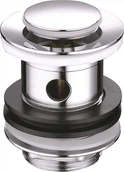A slow-draining basin drain can be a frustrating issue in any household or commercial space. As a Basin Drain supplier, I've encountered numerous customers dealing with this problem. In this blog, I'll share some effective troubleshooting steps to help you resolve the slow-draining issue and get your basin drain back to optimal performance.
Step 1: Check for Visible Blockages
The first and simplest step is to inspect the drain for any visible blockages. Hair, soap scum, toothpaste residue, and other debris can accumulate near the drain opening and cause water to drain slowly. Remove the drain cover if possible and use a pair of tweezers or a small brush to pull out any visible debris. This quick fix can often solve the problem, especially if the blockage is relatively minor.
Step 2: Use a Plunger
If there are no visible blockages, a plunger can be an effective tool to dislodge any clogs deeper in the drain. Make sure there is enough water in the basin to cover the plunger cup. Place the plunger over the drain opening and create a tight seal. Push and pull the plunger vigorously for about 20 - 30 seconds. The pressure changes created by the plunger can often break up the clog and allow water to drain freely. Repeat this process a few times if necessary.
Step 3: Try a Homemade Drain Cleaner
For more stubborn clogs, you can try making a homemade drain cleaner using common household ingredients. Combine equal parts of baking soda and vinegar in a cup. Pour the mixture down the drain and let it sit for about 15 - 20 minutes. The chemical reaction between the baking soda and vinegar can help break down the clog. After the waiting period, flush the drain with hot water. This method is environmentally friendly and can be quite effective in removing grease, soap scum, and other organic materials.
Step 4: Use a Drain Snake
If the plunger and homemade drain cleaner don't work, a drain snake can be a great tool to reach and remove deeper clogs. A drain snake is a long, flexible cable with a corkscrew or hook at the end. Insert the drain snake into the drain and turn the handle clockwise to push the snake further into the pipe. Once you feel resistance, try to break up the clog by rotating and pushing the snake. Slowly pull the snake out, bringing the clog with it. This method requires a bit more skill and patience, but it can be very effective for stubborn clogs.
Step 5: Inspect the Drain Trap
The drain trap is a U-shaped pipe located under the sink. It is designed to trap debris and prevent it from entering the main sewer line. Over time, the drain trap can become clogged with hair, food particles, and other debris. To inspect the drain trap, place a bucket under it to catch any water that may spill out. Use a wrench to loosen the nuts on the drain trap and remove it. Clean the drain trap thoroughly with a brush and warm, soapy water. Reinstall the drain trap and make sure the connections are tight.


Step 6: Consider the Type of Drain
Different types of basin drains may require different troubleshooting methods. For example, a Sink With Push Down Plug may have a different mechanism for opening and closing the drain, which can sometimes cause issues. If you have a Black Click Clack Waste, make sure the click-clack mechanism is working properly. And for Bathtub Drain, the clog may be located deeper in the pipe due to the longer length.
Step 7: Call a Professional
If you've tried all the above steps and the drain is still slow-draining, it may be time to call a professional plumber. A professional has the tools and expertise to diagnose and fix more complex drain problems. They can use specialized equipment such as hydro jetting to clean the pipes thoroughly and remove even the most stubborn clogs.
Preventive Measures
To avoid future slow-draining issues, here are some preventive measures you can take:
- Use a drain strainer to catch hair, food particles, and other debris before they enter the drain.
- Avoid pouring grease, oil, and coffee grounds down the drain as they can solidify and cause clogs.
- Regularly clean the drain with a mild drain cleaner or a mixture of baking soda and vinegar to prevent the buildup of debris.
As a Basin Drain supplier, I understand the importance of having a properly functioning drain. If you're experiencing persistent slow-draining issues or if you're looking to upgrade your basin drain, I'm here to help. We offer a wide range of high-quality basin drains to suit your needs. Whether you're a homeowner or a commercial property owner, we can provide you with the right products and advice. If you're interested in our products or have any questions, please feel free to contact us for a purchase negotiation.
References
- "Home Plumbing Repair: A Complete Guide" by John Doe
- "Drain Cleaning 101" by Jane Smith
- Online resources from plumbing associations and manufacturers





